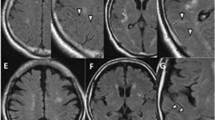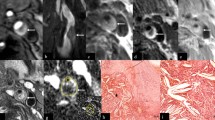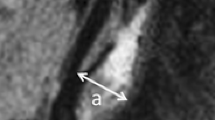Abstract
Introduction
The purpose is to investigate the feasibility of magnetic resonance (MR) plaque imaging in predicting the arterial flow impairment (slow-flow phenomenon) during carotid artery stenting (CAS) using a filter-type protection device.
Methods
Thirty-one carotid artery stenotic lesions in 30 patients (28 men and two women; mean age, 71.8 years) were evaluated by MR plaque imaging with black blood T1- and T2-weighted and time-of-flight sequences before CAS. Main plaque components were classified as vulnerable (intraplaque hemorrhage and lipid-rich/necrotic core) or stable (fibrous tissue and dense calcification) from the signal pattern. The plaque classification was statistically compared with the occurrence of slow-flow phenomenon.
Results
The slow-flow phenomenon was observed in ten CAS procedures (five flow arrests and five flow reductions). Flow arrests consisted of four vulnerable and one stable plaque, and flow reductions consisted of four vulnerable and one stable plaque. The slow-flow phenomenon occurred significantly (P < 0.01) more frequently in patients with vulnerable plaque.
Conclusions
Vulnerable carotid plaques have a significantly higher risk of slow-flow phenomenon than stable plaques. The occurrence of the slow-flow phenomenon can be predicted by MR plaque imaging before CAS.


Similar content being viewed by others
References
Yuan C, Zhang SX, Polissar NL et al (2002) Identification of fibrous cap rupture with magnetic resonance imaging is highly associated with recent transient ischemic attack or stroke. Circulation 105:181–185
Corti R, Fuster V, Fayad ZA et al (2002) Lipid lowering by simvastatin induces regression of human atherosclerotic lesions: two years' follow-up by high-resolution noninvasive magnetic resonance imaging. Circulation 106:2884–2887
Takaya N, Yuan C, Chu B et al (2005) Presence of intraplaque hemorrhage stimulates progression of carotid atherosclerotic plaques: a high-resolution magnetic resonance imaging study. Circulation 111:2768–2775
Takaya N, Yuan C, Chu B et al (2006) Association between carotid plaque characteristics and subsequent ischemic cerebrovascular events: a prospective assessment with MRI—initial results. Stroke 37:818–823
Saam T, Hatsukami TS, Takaya N et al (2007) The vulnerable, or high-risk, atherosclerotic plaque: noninvasive MR imaging for characterization and assessment. Radiology 244:64–77
Yamada N, Higashi M, Otsubo R et al (2007) Association between signal hyperintensity on T1-weighted MR imaging of carotid plaques and ipsilateral ischemic events. AJNR Am J Neuroradiol 28:287–292
Casserly IP, Abou-Chebl A, Fathi RB et al (2005) Slow-flow phenomenon during carotid artery intervention with embolic protection devices: predictors and clinical outcome. J Am Coll Cardiol 46:1466–1472
Palombo G, Faraglia V, Stella N et al (2008) Late evaluation of silent cerebral ischemia detected by diffusion-weighted MR imaging after filter-protected carotid artery stenting. AJNR Am J Neuroradiol 29:1340–1343
Kastrup A, Groschel K, Nagele T et al (2008) Effects of age and symptom status on silent ischemic lesions after carotid stenting with and without the use of distal filter devices. AJNR Am J Neuroradiol 29:608–612
Kim SJ, Roh HG, Jeon P et al (2007) Cerebral ischemia detected with diffusion-weighted MR imaging after protected carotid artery stenting: comparison of distal balloon and filter device. Korean J Radiol 8:276–285
Rapp JH, Wakil L, Sawhney R et al (2007) Subclinical embolization after carotid artery stenting: new lesions on diffusion-weighted magnetic resonance imaging occur postprocedure. J Vasc Surg 45:867–872
Yuan C, Mitsumori LM, Beach KW et al (2001) Carotid atherosclerotic plaque: noninvasive MR characterization and identification of vulnerable lesions. Radiology 221:285–299
Fayad ZA, Fuster V (2001) Clinical imaging of the high-risk or vulnerable atherosclerotic plaque. Circ Res 89:305–316
Kolodgie FD, Gold HK, Burke AP et al (2003) Intraplaque hemorrhage and progression of coronary atheroma. N Engl J Med 349:2316–2325
Saam T, Ferguson MS, Yarnykh VL et al (2005) Quantitative evaluation of carotid plaque composition by in vivo MRI. Arterioscler Thromb Vasc Biol 25:234–239
Saam T, Cai J, Ma L et al (2006) Comparison of symptomatic and asymptomatic atherosclerotic carotid plaque features with in vivo MR imaging. Radiology 240:464–472
Ota H, Yu W, Underhill HR et al (2009) Hemorrhage and large lipid-rich necrotic cores are independently associated with thin or ruptured fibrous caps: an in vivo 3T MRI study. Arterioscler Thromb Vasc Biol 29:1696–1701
Shah PK (2009) Inflammation and plaque vulnerability. Cardiovasc Drugs Ther 23:31–40
Davies MJ (1996) Stability and instability: two faces of coronary atherosclerosis. The Paul Dudley white lecture 1995. Circulation 94:2013–2020
Manninen HI, Rasanen HT, Vanninen RL et al (1999) Stent placement versus percutaneous transluminal angioplasty of human carotid arteries in cadavers in situ: distal embolization and findings at intravascular US, MR imaging and histopathologic analysis. Radiology 212:483–492
Jordan WD Jr, Voellinger DC, Doblar DD et al (1999) Microemboli detected by transcranial Doppler monitoring in patients during carotid angioplasty versus carotid endarterectomy. Cardiovasc Surg 7:33–38
Markus HS, Clifton A, Buckenham T et al (1994) Carotid angioplasty. Detection of embolic signals during and after the procedure. Stroke 25:2403–2406
Theron JG, Payelle GG, Coskun O et al (1996) Carotid artery stenosis: treatment with protected balloon angioplasty and stent placement. Radiology 201:627–636
Ohki T, Veith FJ, Grenell S et al (2002) Initial experience with cerebral protection devices to prevent embolization during carotid artery stenting. J Vasc Surg 36:1175–1185
Henry M, Amor M, Henry I et al (1999) Carotid stenting with cerebral protection: first clinical experience using the PercuSurge GuardWire system. J Endovasc Surg 6:321–331
Albuquerque FC, Teitelbaum GP, Lavine SD et al (2000) Balloon-protected carotid angioplasty. Neurosurgery 46:918–921
Parodi JC, Mura RL, Ferreira LM et al (2002) Safety maneuvers to prevent embolism complicating endovascular aortic repair. J Vasc Surg 36:1076–1078
Reimers B, Corvaja N, Moshiri S et al (2001) Cerebral protection with filter devices during carotid artery stenting. Circulation 104:12–15
Martin JB, Pache JC, Treggiari-Venzi M et al (2001) Role of the distal balloon protection technique in the prevention of cerebral embolic events during carotid stent placement. Stroke 32:479–484
Bejarano J (2005) Mechanical protection of cardiac microcirculation during percutaneous coronary intervention of saphenous vein grafts. Int J Cardiol 99:365–372
Siewiorek GM, Wholey MH, Finol EA (2007) In vitro performance assessment of distal protection devices for carotid artery stenting: effect of physiological anatomy on vascular resistance. J Endovasc Ther 14:712–724
Katzen BT, Criado FJ, Ramee SR et al (2007) Carotid artery stenting with emboli protection surveillance study: thirty-day results of the CASES-PMS study. Catheter Cardiovasc Interv 70:316–323
Takayama K, Nakagawa H, Iwasaki S et al (2008) Initial experience of using the filter protection device during carotid artery stenting in Japan. Radiat Med 26:348–354
Siewiorek GM, Eskandari MK, Finol EA (2008) The angioguard embolic protection device. Expert Rev Med Devices 5:287–296
Finol EA, Siewiorek GM, Scotti CM et al (2008) Wall apposition assessment and performance comparison of distal protection filters. J Endovasc Ther 15:177–185
Angelini A, Reimers B, Della Barbera M et al (2002) Cerebral protection during carotid artery stenting: collection and histopathologic analysis of embolized debris. Stroke 33:456–461
Al-Mubarak N, Roubin GS, Vitek JJ et al (2002) Microembolization during carotid stenting with the distal-balloon antiemboli system. Int Angiol 21:344–348
Burke AP, Farb A, Malcom GT et al (1999) Plaque rupture and sudden death related to exertion in men with coronary artery disease. JAMA 281:921–926
McCarthy MJ, Loftus IM, Thompson MM et al (1999) Angiogenesis and the atherosclerotic carotid plaque: an association between symptomatology and plaque morphology. J Vasc Surg 30:261–268
Mofidi R, Crotty TB, McCarthy P et al (2001) Association between plaque instability, angiogenesis and symptomatic carotid occlusive disease. Br J Surg 88:945–950
Kolodgie FD, Narula J, Yuan C et al (2007) Elimination of neoangiogenesis for plaque stabilization: is there a role for local drug therapy? J Am Coll Cardiol 49:2093–2101
Jeziorska M, Woolley DE (1999) Local neovascularization and cellular composition within vulnerable regions of atherosclerotic plaques of human carotid arteries. J Pathol 188:189–196
Moreno PR, Purushothaman KR, Fuster V et al (2004) Plaque neovascularization is increased in ruptured atherosclerotic lesions of human aorta: implications for plaque vulnerability. Circulation 110:2032–2038
Di Stefano R, Felice F, Balbarini A (2009) Angiogenesis as risk factor for plaque vulnerability. Curr Pharm Des 15:1095–1106
Conflict of interest statement
We declare that we have no conflict of interest.
Author information
Authors and Affiliations
Corresponding author
Rights and permissions
About this article
Cite this article
Sakamoto, M., Taoka, T., Nakagawa, H. et al. Magnetic resonance plaque imaging to predict the occurrence of the slow-flow phenomenon in carotid artery stenting procedures. Neuroradiology 52, 275–283 (2010). https://doi.org/10.1007/s00234-009-0623-7
Received:
Accepted:
Published:
Issue Date:
DOI: https://doi.org/10.1007/s00234-009-0623-7




